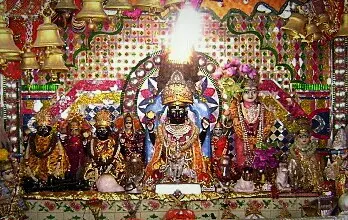Nestled amidst the majestic peaks of the Garhwal Himalayas in Uttarakhand, India, lies the sacred town of Badrinath. Revered as one of the holiest pilgrimage sites for Hindus, Badrinath Dham attracts devotees and travelers alike with its spiritual aura, natural beauty, and rich cultural heritage. This article takes you on a comprehensive journey to Badrinath Dham, exploring its significance, history, attractions, and practical tips for travelers.
 |
| Shri badrinath (Badri Vishal) |
Introduction to Badrinath Dham
Badrinath, also known as Badrinarayan Temple, is dedicated to Lord Vishnu and is one of the Char Dham pilgrimage sites in India, along with Kedarnath, Gangotri, and Yamunotri. Situated at an elevation of 3,133 meters (10,279 feet) above sea level, amidst the picturesque backdrop of snow-capped peaks, Badrinath Dham is not just a religious destination but also a sanctuary of peace and natural splendor.
History and Mythology
The history of Badrinath Dham dates back thousands of years, steeped in Hindu mythology and legends. According to ancient texts, the idol of Lord Badrinath was originally discovered by Adi Shankaracharya in the 8th century CE. The temple has since been renovated and expanded over the centuries, yet it retains its spiritual essence and architectural beauty.
Spiritual Significance
For devout Hindus, visiting Badrinath Dham holds immense religious significance. It is believed that Badrinath is one of the 108 Divya Desams (holy abodes) of Lord Vishnu. The main deity, Lord Badrinath, is depicted in a meditative posture (sitting) and is adorned with rich garments and ornaments during the pilgrimage season (typically from April to November).
The Pilgrimage Experience
The journey to Badrinath Dham is not just about reaching the temple but also about the spiritual and physical challenges encountered along the way. Pilgrims often undertake the journey on foot, following ancient trails that wind through dense forests, river valleys, and steep mountain passes. The sense of camaraderie among pilgrims and the serene beauty of the Himalayan landscape make this journey unforgettable.
Attractions in and around Badrinath
Apart from the main temple of Badrinath, the town offers several other attractions that enrich the pilgrimage experience:
Tapt Kund: A natural thermal spring believed to have medicinal properties, where pilgrims take a holy dip before entering the temple.
Neelkanth Peak: A majestic snow-clad peak visible from Badrinath, associated with the mythology of Lord Shiva.
Mana Village: Known as the last inhabited village before the Indo-Tibetan border, Mana offers insights into local culture and traditions.
Charan Paduka: A rock formation bearing the footprints of Lord Vishnu, located en route to Mana village.
Cultural Heritage
The town of Badrinath is not just a religious hub but also a repository of cultural heritage. The local Garhwali culture is reflected in the architecture of the temple, the cuisine, traditional dances, and folk music. During festivals like Badri-Kedar Utsav and Mata Murti Ka Mela, the town comes alive with devotional songs, dance performances, and rituals that attract pilgrims from far and wide.
Practical Information for Travelers
When to Visit:
The best time to visit Badrinath Dham is during the summer months (May to June) and early autumn (September to October) when the weather is pleasant and the temple is accessible.
How to Reach:
By Road: Badrinath is well-connected by roads from major cities like Haridwar, Rishikesh, and Dehradun. The journey offers breathtaking views of the Himalayas.
By Air: The nearest airport is Jolly Grant Airport in Dehradun, approximately 317 kilometers away. From there, one can hire a taxi or take a bus to Badrinath.
By Rail: The nearest railway station is Rishikesh (around 294 kilometers away). From Rishikesh, one can continue the journey by road.
Accommodation:
Accommodation options in Badrinath range from budget guesthouses to dharamshalas (charitable rest houses) and moderately priced hotels. It is advisable to book accommodation in advance, especially during the peak pilgrimage season.
Tips for Pilgrims:
Carry sufficient warm clothing and sturdy footwear, as the weather can be unpredictable and terrain challenging.
Respect local customs and traditions, especially while visiting the temple and interacting with local residents.
Stay hydrated and carry necessary medications, as the high altitude may cause altitude sickness in some individuals.
Conclusion
A journey to Badrinath Dham is not merely a physical voyage but a spiritual odyssey that rejuvenates the mind, body, and soul. Whether you are a devout Hindu seeking divine blessings or a traveler drawn to the Himalayan mystique, Badrinath offers an experience that transcends the ordinary. With its timeless beauty, cultural richness, and profound spirituality, Badrinath Dham continues to inspire awe and reverence among all who embark on its sacred path.
courtesy and References by-
Uttarakhand Tourism Department
Historical records and mythology
Local guides and residents





